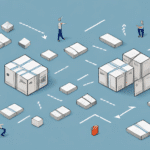Maximizing Efficiency with Ecommerce Integration and 3PL
The world of ecommerce continues to expand and evolve at an unprecedented pace. As a business owner, it is crucial to stay ahead of the competition and maximize your efficiency to drive growth and success in the digital marketplace. One effective strategy is integrating ecommerce with third-party logistics (3PL) solutions. This article delves into what ecommerce integration and 3PL entail, their benefits for your business, and provides actionable tips for successful implementation while overcoming common challenges.
Understanding Ecommerce Integration and 3PL
Ecommerce integration involves connecting your ecommerce platform with third-party logistics (3PL) providers. 3PL companies handle warehousing, shipping, and fulfillment for ecommerce retailers, allowing you to streamline operations and enhance customer satisfaction through accurate and timely product delivery.
Beyond basic logistics, 3PL providers offer value-added services such as inventory management, returns processing, and custom packaging. This eliminates the need for businesses to invest in their own warehousing and logistics infrastructure, enabling them to concentrate on core business functions and scale more efficiently.
A significant advantage of integrating ecommerce with 3PL is the ability to offer faster shipping options. Strategically located 3PL centers can provide same-day or next-day delivery, giving ecommerce businesses a competitive edge against larger retailers and improving the overall customer experience.
The Benefits of Ecommerce Integration and 3PL
Cost Savings
Outsourcing logistics to a 3PL provider can lead to substantial cost savings. By eliminating the need for your own warehousing and fulfillment staff, businesses can reduce overhead costs. Additionally, 3PL providers can negotiate shipping rates with carriers on your behalf, further lowering expenses.
Increased Efficiency
Integrating your ecommerce platform with 3PL solutions automates many fulfillment processes, minimizing errors and delays. According to a report by Statista, the 3PL market is projected to grow significantly, driven by the increasing demand for efficient supply chain management. This automation not only saves time but also reduces operational costs by limiting the need for manual intervention. Outsourcing logistics allows businesses to focus on strategic planning and core competencies.
Improved Customer Service
With 3PL handling logistics, you can offer faster and more reliable shipping options, leading to higher customer satisfaction and loyalty. Enhanced services like returns management and real-time order tracking contribute to a positive customer experience, encouraging repeat business and positive reviews.
Scalability and Market Expansion
Ecommerce integration with 3PL enables businesses to scale operations seamlessly to meet increasing demand without significant investments in infrastructure or personnel. This flexibility allows businesses to enter new markets and reach a broader customer base, driving revenue growth and profitability.
How Ecommerce Integration and 3PL Can Help You Save Money
Integrating ecommerce with 3PL can lead to multiple cost-saving opportunities:
- Negotiated Shipping Rates: 3PL providers leverage their relationships and volume to secure discounted shipping rates, passing the savings onto their clients.
- Reduced Infrastructure Costs: By outsourcing warehousing and logistics, businesses avoid the capital expenditure associated with building and maintaining their own facilities.
- Efficiency Gains: Automated fulfillment processes reduce labor costs and minimize errors that can lead to costly returns and customer dissatisfaction.
- Returns Processing: Efficient returns management by 3PL providers reduces the need for in-house resources dedicated to handling returns.
Moreover, 3PL providers offer real-time visibility into inventory levels and order statuses, enabling businesses to optimize operations and minimize excess inventory costs.
The Role of Technology in Ecommerce Integration and 3PL
Technology is a cornerstone of effective ecommerce integration with 3PL providers. Ecommerce platforms like Shopify and WooCommerce offer built-in integrations with leading 3PL providers, simplifying the connection between your online store and logistics solutions. 3PL providers utilize advanced technologies such as Warehouse Management Systems (WMS), Transportation Management Systems (TMS), and Order Management Systems (OMS) to streamline operations and enhance efficiency.
According to McKinsey & Company, automation technologies play a vital role in reducing manual tasks. Automated order routing, inventory updates, and shipping label generation ensure accuracy and speed in fulfillment processes, leading to cost savings and improved service quality.
Choosing the Right Ecommerce Platform for Your Business
Selecting the appropriate ecommerce platform is essential for seamless integration with 3PL solutions. Key factors to consider include:
- Built-In Integrations: Ensure the platform supports integrations with popular 3PL providers to facilitate easy connectivity.
- Automation and Customization: Look for platforms that offer automation capabilities and customization options to tailor workflows to your business needs.
- Reporting and Analytics: Robust reporting tools are crucial for tracking and optimizing fulfillment operations.
Popular ecommerce platforms with strong 3PL integrations include Shopify, WooCommerce, and Magento. Carefully evaluate each platform to determine which best aligns with your business requirements.
How to Select the Right 3PL Provider for Your Business
Choosing the right 3PL provider is critical for successful ecommerce integration. Consider the following when selecting a provider:
- Service Offerings: Ensure the provider offers comprehensive services, including warehousing, shipping, returns processing, and custom packaging.
- Industry Expertise: Providers with experience in your specific industry or product type are better equipped to handle unique requirements and challenges.
- Location: Strategically located 3PL centers can enhance shipping speeds and reduce costs.
- Pricing Structure: Evaluate the pricing model to ensure it aligns with your budget and offers transparency in costs.
- Reputation and Reliability: Research the provider’s track record, client testimonials, and industry certifications to ensure reliability.
Thoroughly compare different 3PL providers to find the one that best fits your business needs and budget.
Best Practices for Integrating Ecommerce and 3PL Solutions
Successful integration of ecommerce and 3PL solutions requires careful planning and execution. Follow these best practices:
- Define Requirements and Goals: Clearly outline your business needs and objectives to ensure alignment between your ecommerce platform and 3PL provider.
- Choose Compatible Platforms: Select an ecommerce platform and 3PL provider that offer seamless integrations and support automation.
- Effective Communication: Maintain clear and ongoing communication with your 3PL provider to ensure they understand and can meet your expectations regarding delivery times, costs, and quality.
- Establish Metrics and KPIs: Implement key performance indicators to monitor performance and identify areas for improvement.
- Collaborative Relationship: Foster a collaborative partnership with your 3PL provider to ensure continuous success and adaptability.
Implementing Ecommerce Integration and 3PL Successfully
Implementing ecommerce integration with 3PL involves several key steps:
- Define Requirements and Goals: Outline what you need from your 3PL provider and ecommerce platform to ensure they align with your business objectives.
- Select Suitable Platforms and Providers: Choose an ecommerce platform and 3PL provider that meet your requirements and have a proven track record.
- Set Up and Test Integrations: Configure the integrations and conduct thorough testing to ensure data synchronization and functionality are working correctly.
- Train Your Staff: Educate your team on new workflows and processes to facilitate a smooth transition.
- Monitor and Optimize: Continuously monitor performance and make necessary adjustments to optimize operations and efficiency.
Overcoming Common Challenges in Ecommerce Integration and 3PL Implementation
Integrating ecommerce with 3PL can present challenges such as data synchronization issues, employee training gaps, and logistics optimization hurdles. To address these issues:
- Develop a Comprehensive Plan: Anticipate potential challenges and outline strategies to address them.
- Ensure Clear Communication: Maintain open lines of communication with your 3PL provider and internal teams to resolve issues promptly.
- Leverage Expertise: Consider working with consultants or experts in ecommerce integration and 3PL to guide the implementation process and avoid common pitfalls.
Measuring the Success of Your Ecommerce Integration and 3PL Strategy
To evaluate the effectiveness of your ecommerce integration with 3PL, track the following metrics:
- Order Fulfillment Time
- Shipping Accuracy
- Inventory Accuracy
- Order Accuracy
- Employee Productivity
- Return Rates
- Customer Satisfaction
Analyzing these metrics helps identify areas for improvement and supports data-driven decisions to optimize your strategy.
Future Trends in Ecommerce Integration and 3PL
The ecommerce landscape is continually evolving, influenced by technological advancements and changing consumer behaviors. Future trends in ecommerce integration and 3PL include:
- Increased Automation and Robotics: Enhanced use of automation in logistics operations to boost efficiency and reduce costs.
- Artificial Intelligence and Machine Learning: Implementation of AI and machine learning to optimize logistics management and predictive analytics.
- Omni-Channel Fulfillment: Growth in omni-channel fulfillment strategies to meet the demands of consumers who expect seamless shopping experiences across multiple channels.
- Real-Time Data Analysis: Utilization of real-time data and predictive analytics to improve decision-making and operational efficiency.
Staying abreast of these trends ensures businesses remain competitive and can efficiently adapt to the dynamic ecommerce environment.
Case Studies: Real-Life Examples of Successful Ecommerce Integration and 3PL Implementation
Here are some real-life examples of businesses successfully integrating ecommerce with 3PL solutions:
- Warby Parker: The eyewear retailer partnered with 3PL provider Invesp to manage warehousing and fulfillment operations. This collaboration allowed Warby Parker to focus on core areas like marketing and product design, fueling rapid growth and establishing a strong presence in the ecommerce space.
- Bonobos: This men's clothing brand utilizes a hybrid fulfillment model, combining in-house fulfillment with 3PL provider Quiet Logistics. This approach enables Bonobos to maintain control over crucial processes like inventory management while leveraging external expertise to enhance efficiency and reduce costs.
Tips for Scaling Your Business with Ecommerce Integration and 3PL
Scaling your business through ecommerce integration and 3PL requires strategic planning and execution. Consider the following tips:
- Choose Scalable Solutions: Select an ecommerce platform and 3PL provider that can grow with your business and accommodate increasing demands.
- Invest in Technology and Automation: Utilize advanced technologies to streamline operations and reduce operational costs.
- Continuously Monitor and Optimize: Regularly assess your logistics operations to identify opportunities for growth and improvement.
- Maintain Open Communication: Foster transparent communication with your 3PL provider and internal teams to ensure alignment on goals and strategies.
- Adapt and Evolve: Be prepared to modify your ecommerce integration and 3PL strategies as your business evolves to meet changing market conditions and consumer expectations.
In conclusion, integrating ecommerce with 3PL solutions can significantly enhance efficiency, reduce costs, and drive growth in the digital economy. By adhering to best practices, leveraging technology, and maintaining strong communication, businesses can successfully implement ecommerce integration with 3PL providers and achieve long-term success and profitability.




















